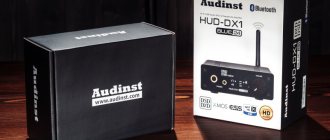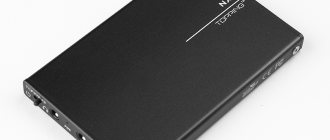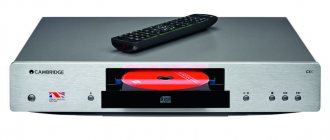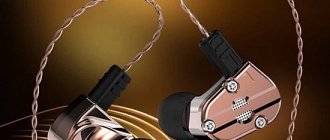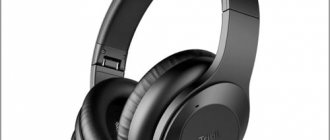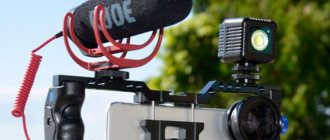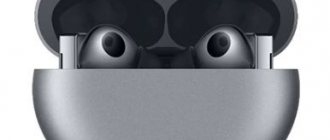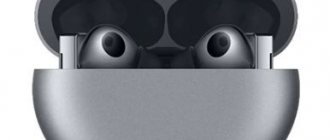Cambridge Audio DacMagic 100 is a very budget digital-to-analog converter from the UK. DacMagic 100 has been in production since 2008 and is still on the market, that is, it is already more than 10 years old! We undertook this review to understand how relevant a DAC like this can be with such rapid development of technology, when new iPhones are released at a rate of almost 3 per year.
Cambridge Audio DacMagic 100, silver
Constructive
There are no questions regarding the appearance of the device. The modest-sized body fits in the palm of your hand. Classic design, 5 mm thick aluminum front panel adds solidity to the appearance. By the way, I liked the silver version of the device more than the black version, perhaps because it matches my MacBook better. The compact form factor of the DAC was clearly intended more as a desktop box than a device for a Hi-Fi rack. In addition to the device itself, the kit includes an external power supply, instructions and even a USB cable (Type A - Type B) for connection.
Cambridge Audio DacMagic 100 kit
Everything is packed with English scrupulousness and there is even a soft fabric bag with the name of the manufacturer, although without ties. You look at the front panel of the Cambridge Audio DacMagic 100 and begin to realize the age of this device. The first to catch your eye are the indicators that highlight the current frequency of the transmitted signal. 44.1, 48... well at least there are 192.
Specifications
| DAC | ESS9023 |
| Output voltage | 2 V avg. sq. |
| Maximum power | 150 mW |
| Minimum headphone impedance | 12 ohm |
| frequency range | ±0.2 dB; 20 Hz – 20 kHz |
| Total harmonic distortion taking into account noise in the frequency range | |
| Signal-to-noise ratio at 1 kHz | 103 dB (unweighted) |
| Crosstalk | 66 dB |
| Output impedance | 0.5 ohm |
| Volume control discreteness | 54 levels |
Switching
Switching Cambridge Audio DacMagic 100
The switching capabilities are simple, but there is everything you need: an optical input, 2 coaxial and USB-type B, there is no talk of any wireless capabilities. Source selection is carried out by pressing a key on the front panel. There are no frequency restrictions, depending on the connection method. If you are using Windows in conjunction with a USB connection, do not forget to install the appropriate driver for the DacMagic 100; it will enable support for USB 2.0 and the ability to pass signals with characteristics up to 24/192. The central element of the DAC is the Wolfson WM8742 chipset, a popular and fairly widely used component; it has been repeatedly used in Cambridge Audio CD players and other famous Hi-Fi manufacturers.
How to choose a digital-to-analog converter?
Which DAC is better to buy? A rather complex question at first glance can be easily resolved if you follow the recommendations below. Before making a purchase, you need to clearly define the purpose of the new device and your expectations from it. Should you think about purchasing a professional converter without having an equally high-quality audio system? Does it make sense to buy a budget converter and expect high-quality sound from it? The modern market offers a wide variety of options for selecting the required model with different characteristics and costs. The selection criteria are quite simple. What you need to pay attention to first:
- Number and type of digital inputs.
This parameter directly depends on the devices that are planned to be used as a sound source. Modern converters are most often connected to a computer using a USB port. In addition, optical and electrical (coaxial) connection types are used. Professional devices also use an “advanced” AES/EBU connection using balanced cables that are not subject to interference from the external environment. Recently, models with the ability to connect to external devices using Bluetooth or Wi-Fi are increasingly appearing.
- Optimal bit depth and sampling rate
These characteristics determine the quality of playback, since they are responsible for the accuracy of signal conversion. Bit depth is an indicator of the number of signal levels at the output of the converter. For audio recordings on CDs, the bit depth is 16 bits, and for high-resolution audio (Hi-Res) it is 24 bits or higher. Sampling rate is the number of reports per time period during digitization. For a CD audio track this figure is 44.1 kHz, DVD - 48 kHz, Hi-Res - 96 kHz or 192 kHz, etc.
- Type of analog outputs
The type of outputs is determined by the inputs of the speaker system. For example, to connect to an audio system with balanced inputs, the DAC must have such outputs. Most converters are equipped with one or more headphone outputs (jack or mini-jack).
- Dimensions
The dimensions of the device primarily depend on its purpose. Recently, models with compact sizes have been gaining popularity. Such devices easily fit in your pocket and are most often used to convert an audio signal from a smartphone or tablet. For particularly demanding connoisseurs of high-quality music, larger stationary options with expanded functionality are more suitable.
- Additional functions
Among the additional functions that may be very popular, it is worth highlighting:
- the presence of analog inputs and the ability to adjust the outgoing signal (using the device in preamplifier mode);
- presence of a lamp output;
- presence of headphone output;
- ability to connect to the device using wireless networks;
- control using remote control, etc.
- Device cost
In this case, the maximum price of the device is determined not only by the financial capabilities of the buyer, but also by what audio equipment and digital signal source will be used. There is no point in buying an expensive DAC if you are using a weak audio system. However, you should not save money if you plan to replace it or upgrade it to a higher quality level in the future.
- Brand influence
Which company's converter is better? According to buyers, it is better to focus on brands that have been proven over the years. Among the recognized world leaders in the production of digital-to-analog converters are the Japanese company Teac, the British Cambridge Audio, the Austrian Pro-Ject and many others. These are those manufacturers who have been able to gain popularity around the world and will certainly not allow a potential buyer to be disappointed in their products.
- Listening
It is extremely important to hear a potential acquisition live before purchasing. If this is not possible, then you should definitely read the reviews of real owners of such devices or experts. Below is a rating of popular models of digital-to-analog converters with a description of their technical characteristics, as well as advantages and disadvantages.
Listening
Internals of DacMagic 100
In our setup, we will listen to music from a MacBook via a USB connection (which, by the way, supports asynchronous mode). At first, the DAC stubbornly refused to transmit the desired 192 kHz. It turned out that we forgot to enable USB 2.0 support on the device itself. This is done using the source button (everything is described in detail in the instructions). The volume and detail of the transmitted musical material fully corresponds to the level of the device. The sound is open, quite light, but too straightforward. This presentation of material will be most interesting for modern electronic and dynamic rock music. Pop hits, if you don't take into account the old classics, sound detailed and convincing. I would like to point out that I am writing such conclusions 10 years after the device was released, when my ears have already been spoiled by various high-res players. The task of finding a system that would soulfully play jazz classics in the budget of the DacMagic 100, although solvable, is not very simple. I had to listen to DACs that perfectly conveyed “tearful music scenes”, but at the same time completely killed the dynamics. In this regard, DacMagic 100 easily gets an A for density and attack in the bass.
DAC Cambridge Audio DacMagic 100, black
Best Portable DACs in 2022
Portable inverters are becoming increasingly popular. They are extremely convenient to use, because they are often a USB module or a miniature block, slightly larger than a matchbox. Such devices, as a rule, are relatively inexpensive - their average price does not exceed 10,000 rubles, there are models costing up to 2,000 rubles. True, their functionality is very limited and is aimed at the most unassuming user.
| Fiio Taishan-D03K | Pro-Ject DAC Box E | M-Audio Micro DAC 24/192 | Cambridge Audio DacMagic XS | M-Audio Super DAC | |
| Max.bit size, bit | 24 | 24 | 24 | 24 | 24 |
| Max.sampling frequency, kHz | 192 | 192 | 192 | 192 | 192 |
| Signal to noise ratio, dB | 95 | — | 114 | 103 | 117 |
| Line input | — | — | — | — | 1 |
| Coaxial input | 1 | 1 | — | — | 1 |
| Optical input | 1 | 1 | — | — | 1 |
| Line output | 2 | 1 | — | — | 1 |
| Optical output | — | — | 1 | — | — |
| Connecting to headphones | mini jack 3.5 | — | mini jack 3.5 | mini jack 3.5 | jack/mini jack |
| USB | Yes | No | Yes | Yes | Yes |
| Dimensions, mm | 62x21x49 | 120x32x100 | 71x23x10 | 30x53.5x10 | 90x30x90 |
| Weight, kg | 0.05 | 0.25 | 0.03 | 0.1 | 0.21 |
| Average price, r | 2200-2500 | 6600-7000 | 8000-9800 | 9600-14000 | 16000-20000 |
Fiio Taishan-D03K
A real bestseller and a leader in price-quality ratio. So compact and discreet that you can hide it anywhere. The inside of the device is packaged so compactly that one gets the impression that it consists of only connectors. There are several of them at once: optical and coaxial at the input and two linear plus a mini-jack for headphones at the output. But you won’t be able to connect to a PC via USB - the port is used only for power. The audio chip significantly improves sound quality, the gain reaches 3.5 dB, and the harmonic distortion does not exceed a hundredth of a percent - a very decent indicator for a portable device.
Fiio Taishan-D03K
Advantages:
- coaxial and optical inputs with switch;
- audio signal support up to 24 bit/192 kHz;
- simple and easy to use;
- miniature sizes;
- LED signal presence indicator;
- inexpensive price;
- headphone output mini jack 3.5 mm;
- cable and power supply included.
Flaws:
- using Mini-USB rather than Micro;
- lack of ability to adjust the incoming signal;
- Not the best sound when using headphones.
Project DAC Box E
Inexpensive converter with a minimum set of functions. Despite its low price, it has quite high-quality sound when used with a completely different audio equipment. All RCA connectors have gold-plated contacts, leadless SMD components are used inside the design, and additional electronic shielding is provided - all this minimizes the level of noise and interference and makes the device operate stable. The output connectors of the device are absolutely not demanding on the quality of cables due to high linearity, and the high signal level allows the use of any amplifiers. Its compact dimensions allow it to be hidden in a rack with equipment and not be disconnected from the network due to its high energy efficiency. In terms of sound quality, the device is far superior to players with standard sound cards, so the DAC Box E will be an excellent addition to any stereo system, even an entry-level one.
Project DAC Box E
Advantages:
- stable operation and low level of interference due to the use of SMD technologies;
- reduction of noise and interference in the output stage due to the use of gold-plated RCA connectors;
- compact overall dimensions;
- no problems with cables due to low input impedance;
- reduced power consumption when using Standby mode;
- high-quality signal processing and filtering.
Flaws:
- no headphone output;
- lack of USB connectivity.
M-Audio Micro DAC 24/192
A miniature device that looks like a regular USB flash card. Some people classify this type of DAC as an external sound card, but this is not entirely correct. There are two outputs on the case - digital optical and 3.5 mm mini-jack. The device is equipped with gain control, which allows you to use headphones with different impedances. To reduce interference and interference, the USB plug and mini-jack connector are gold-plated. Additional noise protection is provided by SMD components, the use of which significantly influenced the price of this model, which cannot be called affordable.
M-Audio Micro DAC 24/192
Advantages:
- high-quality sound;
- high-quality aluminum housing;
- the ability to convert audio signals up to 24 bits and 192 kHz;
- optical output and 3.5 mm headphone jack;
- gold-plated USB plug and mini-jack;
- presence of gain control;
- digital optical cable included;
- good assembly and components;
Flaws:
- Windows driver problems;
- small number of exits.
Cambridge Audio DacMagic XS
A miniature DAC that functions as a telephone amplifier or converter for connecting a tablet or laptop to a stereo system. Lightweight and compact, thanks to the aluminum body (dimensions smaller than a matchbox). The signal is received via the USB connector. The main distinguishing feature of this device is the ability to adjust the volume (as many as 54 levels!), and this happens immediately when connected to a source. The device is powered directly from the device to which it is connected. This affects its charge level, although not very significantly. DacMagic XS is famous for its good audio path - almost all interference and noise are filtered. Therefore, this DAC will be an excellent solution for those who like to listen to music from mobile devices.
Cambridge Audio DacMagic XS
Advantages:
- compact dimensions;
- excellent sound quality with subtle highlighting of instruments;
- unusual design;
- powerful output signal 105 MW;
- transferring the volume control function to the device when connected to a computer;
- ultra-precise volume control;
- elimination of noise and interference through high-quality filtration.
Flaws:
- frequent problems with the micro-USB connection;
- periodically heats up during use;
- quite high price
M-Audio Super DAC
Compact model for advanced users from the American company M-Audio. The converter is compact in size and does not take up much space. On the top panel there is a volume control and LED indicators that display the operating mode and the current sampling frequency. Thanks to multiple inputs and outputs, the device can work with several devices simultaneously. The choice of device for playback is carried out using a special switch. The Super DAC is equipped with two headphone jacks - a 3.5mm mini-jack and a gold-plated 6.3mm full-size jack. The converter can be powered via a USB cable when connected to a computer.
M-Audio Super DAC
Advantages:
- attractive appearance;
- the ability to select 6 different sampling rates;
- two headphone outputs;
- convenient control;
- compact dimensions;
- three types of inputs: optical, linear and coaxial;
- excellent chip from Wolfson;
- Availability of a power supply as standard.
Flaws:
- high price;
- need to install drivers.
conclusions
To summarize, I propose to return to the question we posed at the beginning. How relevant is the Cambridge Audio DacMagic 100 today? There are a lot of polar reviews about this model on the Internet, on forums and in stores, and the debate is still raging. In my opinion, this is a sign of continued interest in the DAC. When I talk a lot with customers, I often hear about the same story. There is a relatively old and inexpensive amplifier that you are used to, that you like, and that you don’t want to part with, and you want to connect your favorite stereo system to your TV or play music from your computer. Very often we are even talking about banal MP3 files. As a rule, such requests come from older people or from those who inherited such a system but do not have money for a new one. In such cases, I can safely recommend trying to revive your system with DacMagic 100, even though it is already 10 years old!
Mandatory upsampling
Well, now the most important point. Regardless of the source parameters, any signal in DacMagic Plus is upsampled to 24 bits/384 kHz. The Analog Devices ADSP-21261 signal processor is responsible for this operation. This chip, which belongs to the third generation of the high-performance SHARC line, is programmed in accordance with ATF2 algorithms developed by the Swiss company Anagram Technologies.
Such a digital switching kit is almost impossible to find these days.
ATF stands for “Adaptive Time Filtering,” and the essence of this technology is interpolation of the signal envelope using polynomials. According to the creators, it works much more correctly than other upsampling methods. In addition, the process provides deep buffering of the digital stream to suppress jitter. Apparently, Cambridge Audio really takes the capabilities of ATF2 very seriously, because in DacMagic Plus it is not possible to disable it in principle.
So, we have before us a fairly advanced DAC, to which, in addition to a computer via USB and mobile gadgets via Bluetooth, you can connect two more digital sources via S/PDIF. Thus, for example, you can integrate an SACD player, satellite receiver or game console into the setup. The subtlety is that DacMagic Plus is a purely stereo device, and it does not decode multi-channel Dolby Digital or DTS streams. However, their switching does not cause problems, so no one bothers to receive 5.1 bitstream from the digital output and send it further to the home theater receiver.
By the way, an interesting point is that no signals are upsampled before being sent to the S/PDIF output, due to which the device can be used as a transmission media converter. For example, to connect some exotic DAC to a computer that cannot work independently via USB.

